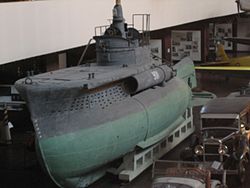Small submarine type CB (Italy)
|
Front view of CB 20
|
||||||||||||||
|
||||||||||||||
|
||||||||||||||
|
||||||||||||||
|
||||||||||||||
|
||||||||||||||
Type CB is a miniature submarine of the Italian Navy , which was designed during the Second World War towards the end of 1940 in collaboration between the Caproni works and the Italian Major Francesco Spinelli of the Italian Naval Engineer Corps ( Italian Genio Navale ). The type CB went into series production and was the most built miniature submarine type in the Italian Navy.
Development history
The type CB was successor of the type CA . The first two test boats, which were given the designation CB 1 and CB 2 , were subjected to extensive sea trials in January 1941. The Italian naval command certified the CB a very good seaworthiness. After the boats CB 3 , CB 4 , CB 5 and CB 6 had also been delivered in May 1941 and the year 1942 showed the military use, the naval command decided on mass production, which should initially consist of 72 boats. A monthly production of six boats was announced, with six boats each to form a squadron. The original plan of 72 boats could not be retained, however, as other maritime small-scale weapons demanded important resources, so that the number of planned boats fell to 50. By the time of the Cassibile armistice , only 22 boats had been completed, 12 of them before the armistice and 10 after.
The primary weapons of the CB consisted of two 45 cm torpedoes , which were attached above the waterline on both sides of the hull.
Stakes and whereabouts
The 1st CB boat squadron was set up in mid-1941 and comprised the small submarines CB 1 to CB 6 . These were used to protect the ports of Naples and Salerno . Lack of tasks carried out in 1942 its laying in the in the first half of the Black Sea with barracks Constanta . There were numerous missions and enemy contacts with the Soviet Black Sea Fleet . After the conquest of Crimea by the German Wehrmacht , the ports of Sevastopol and Yalta were used as further starting points. On June 15, 1942, the Soviet submarine SC 208 was sunk by CB 3 . On June 18, 1942, SC 214 was sunk by CB 2 . CB 4 sank the Soviet submarine SC 207 on August 26, 1942 . CB 5 was destroyed in the port of Yalta by a Soviet air raid. CB 1 to CB 4 and CB 6 were taken over by the Romanian Navy after the surrender of Italy . It can be assumed that they were scrapped after the end of the war.
The 2nd CB boat squadron, which was set up shortly before the surrender in August 1943, to which boats CB 7 to CB 12 belonged, served with boats CB 8 to CB 12 on the Allied side for submarine hunting exercises and for training purposes. CB 7 came into German hands, but was not used and destroyed.
When the armistice came into force, the boats CB 13 to CB 22 , which should have formed the 3rd CB boat squadron, all came into the service of the fascist RSI and thus came under German control. CB 13 , CB 14 , CB 15 , CB 17 and CB 21 were destroyed by air raid. CB 16 ran aground in a special operation and CB 18 was lost in combat. CB 19 , C 20 and CB 22 fell into Yugoslav hands after the end of the war and CB 20 is now a museum exhibit in Zagreb .
literature
- Harald Fock: Naval small weapons. Manned torpedoes, small submarines, small speedboats, explosives yesterday - today - tomorrow. Nikol, Hamburg 1996, ISBN 3-930656-34-5 , pp. 42-44.
